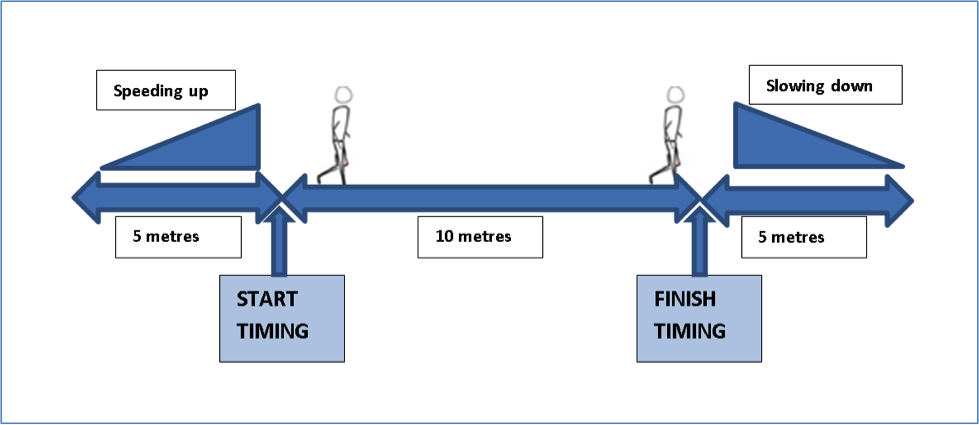In this two-part series of blog posts on walking speed we look at what you need to know and how to improve your walking speed. In Part 1, we'll look at some of the basics and a simple test you can do to determine your walking speed. In Part 2, we discuss how to improve your walking speed.
What advice do you have about walking as I get older?
Walking speed (gait speed) or mobility is necessary for most tasks that humans undertake. Slowing of walking speed is associated with aging in all persons. Walking speed has also been associated both with how long a person will live (survival) (1;2) and with changes that occur when older persons are having difficulty or become unable to do tasks (3;4). In research studies walking ability has been assessed by tests where persons are either asked to walk at their usual speed (sometimes called self-selected walking speed) OR fast walking speed where a person is instructed to walk as fast as they can safely (5-12).
How fast do I need to walk to cross the road safely?
To undertake various activities within the community that involve walking, the average distances required to walk vary from 200-600 metres (13;14). The task that usually concerns older persons most in relation to walking speed is how quickly they need to walk in order to cross a road safely. The critical speed cited for this task is 1.14 meters/second and has been broken down in the following way:
- Crossing a 2 lane road (4 metres/lane) in 10 seconds (5 seconds per lane),
- And 3 seconds to get up and down off either curb (1.5 seconds per curb).
- The critical speed is 8 metres/7 seconds = 1.14meters/second.
The speed we are able to walk decreases as we age. There are several reports that indicate some normal ranges for older persons. For example, general walking speeds for community activities are 1.2-1.4 metres/sec until 80 years and 1.0-1.8 metres/second until 90 years and older (4;15-18).
Older persons who have a walking speed of less than 1metre/second have reported ceasing involvement in any regular physical activity (19). Self- selected walking speed associated with frailty has been reported as less than 0.65 metres/second if you are short (i.e. = 159cm) and 0.75m/sec if you are taller (height >159cm) (20).
How does my walking speed compare to others of my age?
Below is a Table (16) of usual walking speeds given for women and men by different age groups.
| Sex | Age group | Total number of persons in each study | Average self-selected walking speed (metres/second) | Range within which the average value might fall (metres/second) |
| Women | 40-49 | 142 | 1.39 | (1.34-1.41) |
| 50-59 | 456 | 1.31 | (1.22-1.41) | |
| 60-69 | 5,013 | 1.24 | (1.18-1.30) | |
| 70-79 | 8,591 | 1.13 | (1.07-1.19) | |
| 80-99 | 2,152 | 0.94 | (0.85-1.03) | |
| Men | 40-49 | 96 | 1.43 | (1.35-1.51) |
| 50-59 | 436 | 1.43 | (1.38-1.49) | |
| 60-69 | 941 | 1.34 | (1.26-1.41) | |
| 70-79 | 3,671 | 1.26 | (1.21-1.32) | |
| 80-99 | 1,091 | 0.97 | (0.83-1.10) |
Assessing your own walking speed
You can assess your walking speed using the 10 metre walk test (5;8;10). You need a 20 metre path with 5 metres to get up to normal speed, 10 metres for measurement of your normal walking pace and 5 metres to slow down. You should measure how long it takes you to walk the 10 metre length or get someone else to time your walking speed over this distance. The figure below illustrates how to do this. Then calculate your walking speed by dividing 10 metres by the number of seconds it took you to determine your speed in metres/second.

In Part 2 of this two-part blog series on walking speed, we discuss how to improve your walking speed.


.jpg?sfvrsn=f7060fd6_0)


